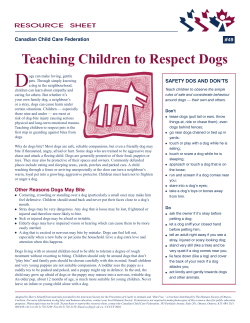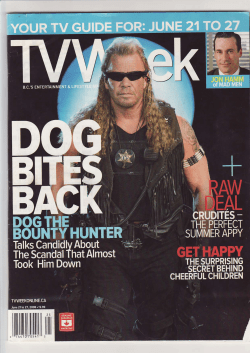
Training Your Basenji
Course # 101 Owner’s Guide Basenji University “Preserving Our Past and Educating Our Future” Training Your Basenji Providing some basic training for your Basenji will make him a safer and happier pet and a more welcome member of your family. Participating in a local obedience class can be a rewarding experience for both you and your new puppy or adult companion. Local dog clubs, veterinarians, pet supply stores and local newspapers may have information about classes available in your area. Whether you choose to go to a class, or proceed on your own at home, a few basic commands will help your pet become a socially acceptable member of A well trained Basenji can do many things your family. Basenjis do not respond well to harsh training. They need an encouraging and rewarding atmosphere with the use of positive reinforcement. There are many books and websites about positive reinforcement training. The method using clicker training is particularly good for Basenjis. This method was developed by captive wild animal trainers and seems particularly applicable to “wild” Basenjis. This is a not an easy method to learn. If you would like to study it there are videos on the internet to introduce the technique but the best way to master it is in a class or seminar that teaches it. Don't let bad habits become normal Basenji University #101 Owner’s Guide 1 Every interaction your puppy has with his environment and with you teaches him something. Puppies learn quickly…they can learn to behave well from the beginning or they can learn to behave as they see fit. Rather than allowing your Basenji to develop bad habits, basic training should begin as soon as possible after you bring your pet home. If you can find a puppy kindergarten class you will have a good start. If there are none available, you can begin with some exercises at home. One of the advantages of starting training early is the dog learns to learn. He learns to try to work out what it is you want him to do. With some dogs, this is like a light bulb going on in their brains. Once they understand there is a method to your madness, they will try to participate in the training because they like getting the reward. When that understanding is reached you will have begun a true partnership for learning with your adult or puppy Basenji. Both young puppies and more mature adults can begin to learn the basics. Patience, persistence and practical knowledge will aid you in training your Basenji. Training times should be short – no more than five or ten minutes. It is important that you and your dog enjoy the experience. Basenji University #101 Owner’s Guide 2 Rewards and Praise Enthusiastic praise for a correct behavior is a big key to successfully training your hound. Training should start with the use of treats. Once habits are established and the commands are understood by the dog, food treats can be used intermittently. The dog will never quite know when to expect them and will happily work with the hope that it is a treat time. Why does your dog drag you around on the leash…Don't they always get where they want to go by dragging? Also, dogs have a very strong urge to resist pressure. When they feel the pressure on their necks, they can't help but pull against it. You need to stop allowing pulling to work for him. They jump up on people because it works to gain attention. If you want your puppy to learn the correct habits from the beginning, you can do that by rewarding the good behaviors while ignoring or distracting him from the bad behaviors right from the very beginning. This dog responds well to praise Basenji University Quite young puppies can learn advanced obedience exercises if you make it fun and worthwhile for them. Note: Treats used in training as lures and rewards should be tiny. The dog should have eaten them before you realize they could be gone. If the dog must stop and chew, it distracts from the lesson. Additionally, you want to be able to carry a fair amount in your pocket. Be sure to adjust the pup’s food intake at meals if you are using treats for training. #101 Owner’s Guide 3 No! For your puppy’s safety, “No” should be one of the first word you teach. “No” is your puppy’s signal to stop whatever it is doing immediately. Sometimes it seems as though every Basenji thinks “No” must be its name as it is used so often for such a curious breed. Do not use the dog’s actual call name with any correction. His name should only be associated with good experiences. Leash Training The objective of leash training is to have a Basenji who walks along on leash without pulling you. An adult Basenji is quite strong despite its weight and there will be no joy of taking your dog for a walk if you are constantly pulled along. A lightweight buckle collar is the best choice to start your puppy’s early leash training. Let your puppy get used to the feel of the collar and when he is accustomed to it, clip a leash on and let him drag it around as he pokes around in a relatively quiet place. Once he seems used to the feel of the collar, encourage him to follow you for a few steps at a time, and gradually lengthen the distance. Praise your puppy when he follows, and give him encouragement with voice and treats. Keep these lessons very brief. Try not to let the leash get any pressure from the hound pulling during these sessions. Do not try walking the puppy in very interesting places too soon or he will learn to pull toward every attraction. You need to get some control before putting too much temptation in the path. The earlier you start, the earlier he will learn this lesson. If you have another dog who is good on the leash, it often helps to walk them together so the puppy learns by copying the adult. This puppy can learn to walk on a leash! Constant repetition and many sessions will have a puppy that walks with you, aware of where you are and how long the leash is. As you walk in more interesting and tempting places the reward for keeping track of you may have to be raised so the treats become a better, more interesting diversion then whatever is attracting the puppy. Basenji University #101 Owner’s Guide 4 The Sit and Down The objective is to teach your dog to sit and down on command. This will help you control your Basenji in different situations. Sit before crossing the street, sit when people come into the home and lie down quietly while people are visiting or you are eating your meals or any of a number of situations where sit and down responses can be useful. Your puppy can learn the sit and down easily with positive reinforcement methods. This training can be done in your home or backyard. It is best that the dog is not on a leash for this training and that there are no distractions around. You need to have the Basenji’s attention on you. Make the whole procedure fun for you and your hound. With the puppy standing and you on your knees (with an adult dog you may want to stand) with a small treat in your hand move it slowly from his nose up and back a bit over his eyes but slightly out of reach. The treat acts as a lure to shift his weight so that he brings his rear down. Say “Sit” and give the treat to the dog while it is still sitting. Don’t let him pop up first or he might think the treat is for popping up quickly rather than sitting. As his head goes back his weight shifts bringing his rump down so she is sitting and happily earns her reward If the dog tends to back up when you try to lure him into a sit, have him standing with his rear at a wall or other object so that he can’t back up. When he sits or at the very beginning nearly sits, give him the treat reward. Do this very promptly so that he can understand what action is being rewarded. If you try clicker training, you will be using the clicker to signal the exact instant the correct action has occurred. As he catches on he should actually sit before the award is given. Introduce the word “sit” as you do the Basenji University #101 Owner’s Guide 5 exercise. By and by you will notice that he starts to sit as you give the command “sit” and this is great progress. It usually doesn’t take long for these clever fellows to catch on to the command and happily sit for a reward. Keep these sessions short so the dog does not get bored. After he is responding regularly, you can sometimes use treats and sometimes praise for his response to your sit request. When the sit seems solid and the dog regularly is responding to sit, you can introduce the command to “down”. With the dog in a sitting position, use a treat as a lure to get him into the down position. Start the treat at his nose, then slowly drop the treat from his nose to the ground as you are reaching the ground go backwards (between his legs) a little bit instead of forward. Say “Down” as he drops then give him his treat. Some dogs drop right away but if your dog is not catching on you can reward him for any action of the elbows dropping toward the ground. Eventually your pup will lie all the way down and then you can reward him with the treat and enthusiastic praise. Hopefully, he will drop into the "sphinx" position. Alternately you can bring the treat down and forward. People who are going to compete with their dogs in obedience trials prefer the first method because there is more of a tendency for the dog to creep forward as he drops in the second method. This adult dog starts from the sit and as her weight shifts works herself down as she tries to get her treat ….which she enjoys in the last photo. Basenji University Most dogs do the down more easily at first from a sit, but for some dogs doing it from a standing position is easier. Eventually the lure will no longer be required and a treat or enthusiastic praise can be used alternately as a reward. #101 Owner’s Guide 6 Leather or Nylon Buckle Collar For puppies and most adults, a leather buckle or nylon collar works well. It is important to adjust the collar correctly so the puppy cannot back out of the collar and pull away from you, running loose without a lead. The left photo shows a properly adjusted collar which cannot slip over the dog’s ears and head, and the right photo shows a collar that is too loose. As the dog pulls away, the collar slips over the ears and head and the dog is gone to lead you on a merry chase if you are lucky and into danger if you are not. Choke collars should not be used on your puppy. Hopefully, a choke collar never will be required. Do not use a choke collar at any age without proper instruction on its use. Always remove a choke collar when they are not in use for training. Choke collars are dangerous and their use should be very limited. Harnesses and Gentle Head Halters (“halti” head harness) While harnesses are becoming popular, they do not give you very much control. The Basenji is a strong dog. It is best to leash train your dog with a buckle collar. A harness tends to teach the dog to pull. You will not be comfortable being pulled everywhere by your Basenji. Control is very important for the safety of you and your dog. Gentle head halters are useful for dogs that have already learned to pull. They are not useful for training. Basenji University #101 Owner’s Guide 7 Choosing an Appropriate Training Class Remember to choose a class that you are comfortable with. There are many ways to train your dog. You need to find what will work for you and your Basenji. If your puppy is not responding well in class and the instructor is not able to communicate with you clearly, drop the class, find another or do your research and train at home. Bad early experience at a poor class can sour your Basenji on the idea of obedience forever. An experienced Basenji breeder and trainer has made a list of web sites where you can find associations of dog trainers with member directories. Find it at course #104 Books to Read. Puppy Kindergarten Puppy Kindergarten is a class designed to give basic training for young puppies. Kindergarten will provide a great venue to socialize your puppy and assist you in teaching your puppy basic commands like come, sit and down. Your trainers at Kindergarten will be able to help solve problems you may be having at home. Novice or Beginning Obedience Classes are designed for adult dogs and puppies over 6 months of age. Beginning obedience commands include heel, stand, sit, down, stay and come. This class provides your dog with the opportunity to learn skills, which will help him to behave well in public, as well as at home. If you have an interest in participating in organized obedience trials, these classes provide a good beginning. Should you then decide to move to more formal obedience training to ready yourselves for obedience competition or agility activities, you and your dog will be better prepared. Useful Training Books: Some Useful Websites: “How To Teach An Old Dog New Tricks” Ted Baer (27 page introduction available at Google Books) “Dog Friendly Dog Training” Andrea Arden (Preview on Google Books) “Perfect Puppy Primer” Patricia B. McConnell “Culture Clash” Jean Donaldson “So Your Dog's Not Lassie” Betty Fisher, Suzanne Delzio “Clicker Solutions” “Dog Star Daily” “Certification Council for Professional Dog Trainers” “Lulu” has a useful download “Before You Get Your Puppy” and another “After You Get Your Puppy” Find Trainer Directories in course #104 Books to Read Basenji University #101 Owner’s Guide 8
© Copyright 2025











